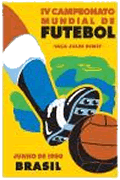FIFA World Cup 1950
 After the hiatus caused by the Second World War FIFA was anxious to resurrect the World Cup but with most of Europe in ruins and governments focusing scarce resources on reconstruction, there was a real danger that the competition would die. At the 1946 Congress, however, Brazil offered to host the tournament on condition that it be held in 1950 (rather than 1949 as planned) and that they would decide the format.
After the hiatus caused by the Second World War FIFA was anxious to resurrect the World Cup but with most of Europe in ruins and governments focusing scarce resources on reconstruction, there was a real danger that the competition would die. At the 1946 Congress, however, Brazil offered to host the tournament on condition that it be held in 1950 (rather than 1949 as planned) and that they would decide the format.
Italy, as winners of the last tournament 12 years earlier qualified automatically but their participation was thrown into doubt by the Superga air disaster in May 1949 in which almost the entire Torino football team, the backbone of the national side, was killed. In the event, Italy did participate but they traveled to Rio de Janeiro by sea.
Germany, still partitioned and under military occupation, was not permitted to enter nor were Japan. The British home nations, having finally joined FIFA, were allowed to use the 1949 and 1950 Home Championships as qualifiers with the top two teams being offered places. The chairman of the Scottish FA, having previously stated that Scotland would only take part if they finished first, withdrew the Scottish team when they finished second. With the exception of Yugoslavia, the iron curtain countries led by the USSR boycotted the competition. There were many withdrawals during qualification leaving several nations to qualify by default. After the draw for the finals took place India withdrew as did France, who had earlier accepted an invitation to replace Scotland leaving 13 finalists.
In order to increase the number of matches and maximise ticket sales, the Brazilian organisers insisted on a return to a round-robin group stage followed by a final group competition. For the first time in the World Cup, players' shirts had team numbers (1-11) on the back.
I am grateful to Glen Isherwood for sharing his research. Please contact me with corrections.
Group 1 | Group 2 | Group 3 | Group 4 | Final Group
1938 | World Cup Index | 1954